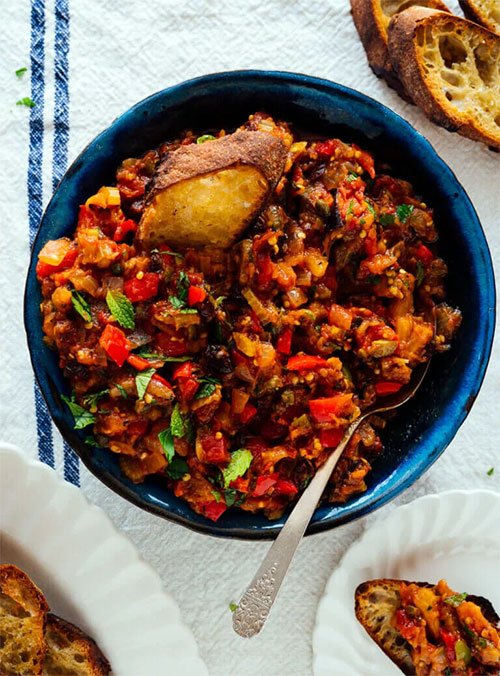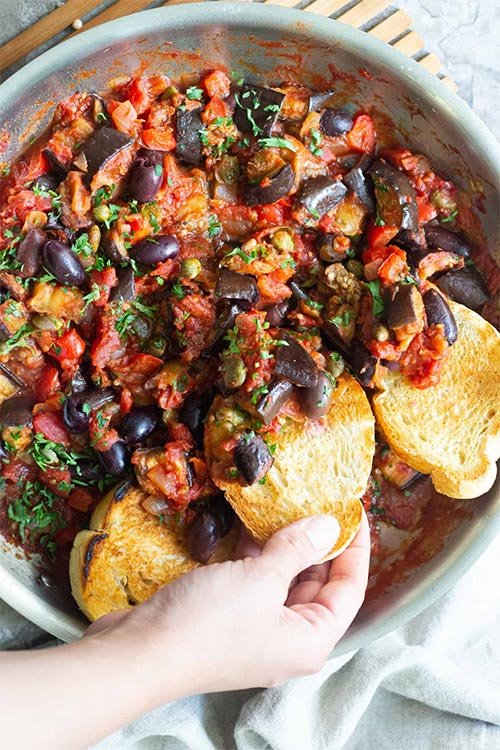Caponata is a vibrant and flavorful Sicilian dish that perfectly encapsulates the island’s rich culinary heritage. This sweet and sour eggplant-based dish is a testament to Sicily’s diverse cultural influences, combining local produce with techniques and flavors introduced by various conquerors throughout history. Whether served as an appetizer (antipasto), a side dish, or even as a main course, caponata offers a delightful explosion of flavors that dance on the palate.
The Essence of Caponata
At its core, caponata is a harmonious blend of contrasts:
- Sweet and Sour: The agrodolce (sweet and sour) sauce is a defining feature of the dish.
- Textures: Soft eggplant contrasts with crunchy celery and pine nuts.
- Flavors: The brininess of capers and olives complements the sweetness of raisins and sugar.
- Colors: A visual feast with the deep purple of eggplant, red of tomatoes, and green of celery and herbs.

@cookieandkate
The Recipe
Ingredients (Serves 6-8 as an appetizer):
- 2 large eggplants (about 2 lbs), cut into 1-inch cubes
- Salt for drawing out moisture
- 1/2 cup olive oil, divided
- 1 large onion, diced
- 2 celery stalks, chopped
- 3 ripe tomatoes, diced
- 1/2 cup pitted green olives, roughly chopped
- 1/4 cup capers, rinsed
- 1/4 cup pine nuts
- 1/4 cup raisins
- 1/4 cup red wine vinegar
- 2 tablespoons sugar
- 1 tablespoon tomato paste
- Fresh basil leaves for garnish
- Salt and freshly ground black pepper to taste
Instructions:
- Place the cubed eggplant in a colander, sprinkle with salt, and let it sit for about 30 minutes to draw out excess moisture. Rinse and pat dry with paper towels.
- In a large skillet or frying pan, heat 1/4 cup of olive oil over medium-high heat. Fry the eggplant in batches until golden brown, about 5 minutes per batch. Add more oil if needed. Remove and set aside on paper towels to drain.
- In the same pan, add the remaining olive oil and sauté the onion and celery until softened, about 5 minutes.
- Add the diced tomatoes, olives, capers, pine nuts, and raisins. Cook for another 5 minutes until the tomatoes start to break down.
- Stir in the red wine vinegar, sugar, and tomato paste. Simmer for about 10 minutes until the sauce thickens slightly.
- Return the fried eggplant to the pan and gently stir to combine. Cook for an additional 5 minutes to allow the flavors to meld.
- Remove from heat and let cool to room temperature. Caponata is traditionally served at room temperature or slightly chilled.
- Before serving, garnish with torn basil leaves and adjust seasoning with salt and pepper if needed.
The Art of Balance
The key to a great caponata lies in achieving the perfect balance of flavors:
- Sweetness: Comes from the raisins and added sugar
- Sourness: Provided by the red wine vinegar
- Saltiness: From the capers and olives
- Umami: Delivered by the tomatoes and eggplant
- Texture: Soft eggplant contrasted with crunchy celery and pine nuts
Historical and Cultural Significance
Caponata’s origins are as complex as its flavors. The dish reflects Sicily’s varied history, with influences from:
- Arabs: Introduced sweet and sour cooking techniques and the use of raisins and pine nuts
- Spanish: Brought tomatoes from the New World
- Greeks: Possibly introduced eggplant to the region
The name “caponata” itself has several theories of origin, including a possible connection to the Latin word “caupona,” meaning tavern, suggesting its popularity as a tavern food.

@unicornsinthekitchen
Regional Variations
While the basic recipe remains consistent, there are numerous regional variations across Sicily:
- Palermo: Often includes octopus or fish
- Catania: Sometimes includes sweet peppers
- Agrigento: May include cocoa powder for added depth
- Messina: Often includes carrots and potatoes
Serving Suggestions
Caponata is versatile in how it can be served:
- As an appetizer (antipasto) with crusty bread
- As a side dish to grilled meats or fish
- As a topping for bruschetta
- Tossed with pasta for a quick main course
- As a sandwich filling
Make-Ahead and Storage Tips
Caponata is one of those dishes that often tastes better the next day, as the flavors have time to meld:
- Store in an airtight container in the refrigerator for up to 5 days
- Bring to room temperature before serving for the best flavor
- Can be frozen for up to 3 months; thaw in the refrigerator overnight
Nutritional Highlights
Caponata is not only delicious but also nutritious:
- Eggplant: Rich in antioxidants and fiber
- Olive Oil: Provides heart-healthy monounsaturated fats
- Celery: Offers vitamins K and C, and antioxidants
- Pine Nuts: Contains protein and healthy fats
- Tomatoes: Rich in lycopene, an antioxidant linked to various health benefits
Conclusion
Caponata is more than just a dish; it’s a journey through Sicily’s rich culinary history. Each bite tells a story of cultural influences, local ingredients, and time-honored traditions. Whether you’re a longtime fan of Italian cuisine or new to these flavors, caponata offers a delightful exploration of taste and texture.
As with many traditional recipes, don’t be afraid to make it your own. Adjust the sweet-sour balance to your liking, experiment with different vegetables, or try one of the regional variations. The beauty of caponata lies in its adaptability and the care put into its preparation.




